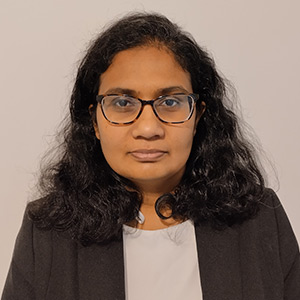Biography
Biography
I obtained my BSc Hons degree in Physics from the University of Jaffna, Sri Lanka in 2008, and my MSc by Research and PhD in Condensed Matter Physics from the University of Nottingham in 2012 and 2015, respectively. I received the EMRS Young Scientist Award in 2012. My areas of expertise are semiconductor physics, material science, and nanotechnology. My PhD project focussed on the fabrication of nanoscale current channels in dilute nitride III-N-V semiconductor compounds. At the end of my PhD, I changed my focus to the emerging new class of 2D materials. I gained 4.5 years of postdoctoral experience, 3 years at the University of Nottingham and 1.5 years at the University of Manchester.
I joined Keele University as a Lecturer in October 2019 and was promoted to Senior Lecturer in May 2024. Since I joined Keele, I have developed my independent research group in experimental 2D materials. My group’s research is focused on understanding the fundamental properties and applications of novel 2D materials. My research is supported by a Royal Society Research grant to understand the feasibility of III-VI van der Waals layered materials for flexible and wearable devices, a British Council Researcher Links Climate Change Workshop Grant to grow metal chalcogenides for sodium ion battery anodes, a Royal Society Short Industry Fellowship to study the surface and interface science of 2D materials using Kelvin probe force microscopy, and an EPSRC grant to synthesis smart electrodes for energy storage devices.
For further information please see my personal webpage of Dr Nilanthy Balakrishnan.
School address
Lennard-Jones School of Chemical and Physical Sciences
Lennard-Jones Building
Keele University
Staffordshire
ST5 5BG, UK
Phone (School Office): +44 (0)1782 733033, (Chemistry): +44 (0)1782 731693, (Forensic Science): +44 (0)1782 731694, (Physics): +44 (0)1782 733527
Email: scps@keele.ac.uk
Information for schools and colleges
Programme directors
Chemistry and Medicinal Chemistry
Dr Tess Phillips
Tel : +44 (0)1782 733038
Email : t.r.phillips@keele.ac.uk
Dr Chris Hawes
Tel : +44 (0)1782 732820
Email : c.s.hawes@keele.ac.uk
Forensic Science and Criminology
Dr Jamie K. Pringle
Tel : +44 (0)1782 733163
Email : j.k.pringle@keele.ac.uk
Victoria Cartwright
Tel: +44 (0)1782733584
Email: v.cartwright@keele.ac.uk
Physics and Astrophysics
Dr Barry Smalley and Dr Joana Oliveira
Email : b.smalley@keele.ac.uk, j.oliveira@keele.ac.uk
Admission tutors
Chemistry and Medicinal Chemistry
Dr Natalie Capel
Tel : +44 (0)1782 733584
Email : n.j.capel@keele.ac.uk
Forensic Science
Sue Shemilt
Email: s.shemilt@keele.ac.uk
Physics and Astrophysics
Dr Juliana Morbec
Email : physics@keele.ac.uk or j.morbec@keele.ac.uk



